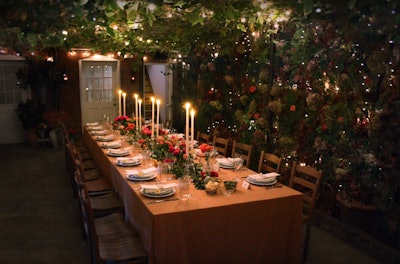
When Michela Giovannotto, BizBash’s director of brand experiences, was planning an intimate dinner party for event professionals last fall, she knew she wanted a diverse guest list.
After all, the event, which drew 16 senior-level event marketers and planners and was hosted in collaboration with BrandSync, was a conversation-based gathering that asked each attendee to answer a single question—"What’s keeping you up at night?"—and Giovannotto knew having a variety of demographics and points of view would make for a more engaging conversation.
But the result was better than Giovannotto could have imagined, with the leaders sharing honest, valuable insights throughout the evening. What’s more, it sparked an ongoing community of monthly meetups, curated by BrandSync and the other dinner participants. “What was really special about this group in particular was that nobody really knew each other that well coming in—but as soon as they started talking, they found so many similarities,” Giovannotto explains.
The BizBash and BrandSync event, and the ongoing community it helped create, underscores the importance of curating the right guest list. To Giovannotto, the success was all about the caliber of people who were brought together. “In one room, we had people who worked in media, finance, insurance, pharmaceutical, and technology,” she points out. “They were all connected on the fact that they were event professionals, but they could all bring something different to the table in terms of their day-to-day experiences.”
Amanda Ma, founder and CEO of event management agency Innovate Marketing Group in Los Angeles, agrees that curating the right guest list is fundamental to the success of any event. “It sets the tone, establishes the caliber of attendees, and shapes the overall experience," Ma says. "By bringing together individuals who can contribute expertise, insights, and opportunities, a curated guest list lays the foundation for meaningful interactions, productive collaborations, and ultimately, a successful event.”
So, where do you begin with this all-important task? We asked Ma and other event professionals to weigh in; here are their top tips.
1. Start with the "why."
“Planning an event should always start with why you are doing an event,” advises Lee Gimpel, president of Washington, D.C.-based meeting design, facilitation, and training company Better Meetings. “Often, planners jump right to executing on the what and how of an event. So a planner might say that he or she is going to do an event for 500 people because that's usually the size that this organization hosts—but if we really get back to why we are going to do this event, the best event may actually be for 20 people, or it might be 10 different events with 20 people, or it might be best served by having 5,000 people.”
Ma agrees. “Identifying key stakeholders, influencers, and individuals aligned with the event's goals is paramount. This initial step ensures that every invitee adds value to the event and contributes to its success," she says, adding: "The event's goals significantly influence the selection process. Whether it's fostering networking opportunities, generating leads, or promoting brand awareness, each goal guides the selection criteria. For instance, if the aim is to attract potential investors, the guest list may prioritize industry leaders, venture capitalists, and entrepreneurs.”
2. Always be conscious of budget and capacity.
Of course, budget, venue size, and other practical constraints can heavily impact your guest list. "It's essential to strike a balance between the number of invitees and the capacity of the venue, ensuring a comfortable and engaging atmosphere for attendees," explains Ma. "Additionally, budget constraints may necessitate prioritizing high-impact individuals who align closely with the event's objectives. It's about achieving a critical mass that fosters meaningful interactions while avoiding overcrowding."
Consider that each additional guest may come with their own additional costs, like travel expenses, adds Carissa Kruse, a business strategist and the owner of Carissa Kruse Weddings in Denver. "I often use the 80/20 rule when determining the number of guests to invite," she notes. "This means inviting 80% of my ideal number, leaving room for unexpected attendees or last-minute changes."
3. Think through the event's format and how it ties into overall goals.
“Format of the event is really important to consider when we think about who we are inviting,” adds Gimpel. “If, for example, the event exists to share knowledge among different groups—but everyone basically just watches a few presenters over the course of the event—then even having the right people there doesn't necessarily help us fulfill the actual goal that we had. Similarly, lots of events that have a networking component or a matchmaking component get really hung up on delivering content rather than maximizing the connections made between all the carefully selected invitees.”
Gimpel shares another example. "An organization might want to do a very fancy dinner in a very fancy venue, but then can only invite a small number of people," he says. "However, hosting an event that is cheaper per capita, even if it's not as fancy, may ultimately pay much bigger dividends for the organization and the attendees—even if they don't rave about the foie gras.”
4. Prioritize conversation.
"Facilitate an environment that fosters conversation," suggests Jim Thornton, BrandSync's vice president of sales. "Elements such as the venue, seating, and food and beverage contribute to a welcoming atmosphere. A host who provides interesting conversation starters and keeps the community focused is critical to a successful event."
Thornton also likes to keep conversations in mind when choosing the guest list, particularly for an intimate event. "It is essential to curate an audience that enjoys participating in the conversation," he says, noting that finding a solid cross-section of talent that shares some commonalities but also brings disparate and unique backgrounds can foster interesting dialogue. "However, be mindful of individuals who tend to dominate or take over discussions. Nothing can disrupt a spirited, robust conversation as someone who doesn’t know how to share the floor."
5. Lean into diversity.
"Diversity across demographics, industries, and perspectives is crucial for a well-rounded and enriching event experience," says Ma. "A diverse guest list fosters creativity, encourages cross-disciplinary collaboration, and broadens perspectives. It ensures that discussions are dynamic, ideas are innovative, and connections are diverse.”
Kruse agrees. "I think the guest list is a crucial element in setting the tone and atmosphere of an event," she says. "Each attendee brings their unique expertise and experience, making the event more impactful and successful."
6. Don’t be afraid to voice your opinion to clients.
Sometimes, it's up to the planner to gently push back, even for something like a guest list. “In many cases, the client is guilty of going through the motions and just inviting people because it seems right or that's who's always been invited or who we would typically invite," points out Gimpel. "Then that guest list is passed off to a planner to execute and deliver an event with those people. I think planners should have a respectful role of pushing back and talking with the client, asking at the very start of the planning process who we truly need to include and also who we don't need to include."
7. But be ready to adapt.
But, Gimpel adds, all planners should be ready to work with what they have. “One of the guiding principles of the Open Space Technology approach to meetings



















